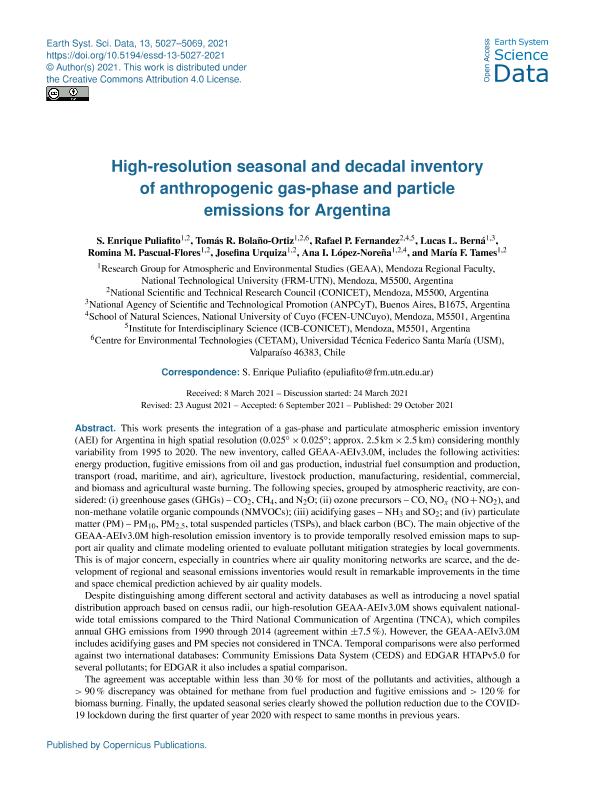Artículo
High-resolution seasonal and decadal inventory of anthropogenic gas-phase and particle emissions for Argentina
Puliafito, Salvador Enrique ; Bolanõ Ortiz, Tomás R.; Fernandez, Rafael Pedro
; Bolanõ Ortiz, Tomás R.; Fernandez, Rafael Pedro ; Berná, Lucas L.; Pascual Flores, Romina María
; Berná, Lucas L.; Pascual Flores, Romina María ; Urquiza, Josefina
; Urquiza, Josefina ; Lopez Noreña, Ana Isabel
; Lopez Noreña, Ana Isabel ; Tames, María Florencia
; Tames, María Florencia
 ; Bolanõ Ortiz, Tomás R.; Fernandez, Rafael Pedro
; Bolanõ Ortiz, Tomás R.; Fernandez, Rafael Pedro ; Berná, Lucas L.; Pascual Flores, Romina María
; Berná, Lucas L.; Pascual Flores, Romina María ; Urquiza, Josefina
; Urquiza, Josefina ; Lopez Noreña, Ana Isabel
; Lopez Noreña, Ana Isabel ; Tames, María Florencia
; Tames, María Florencia
Fecha de publicación:
10/2021
Editorial:
Copernicus Publications
Revista:
Earth System Science Data
ISSN:
1866-3508
e-ISSN:
1866-3516
Idioma:
Inglés
Tipo de recurso:
Artículo publicado
Clasificación temática:
Resumen
This work presents the integration of a gas-phase and particulate atmospheric emission inventory (AEI) for Argentina in high spatial resolution (0.025×0.025; approx. 2.5km×2.5 km) considering monthly variability from 1995 to 2020. The new inventory, called GEAA-AEIv3.0M, includes the following activities: Energy production, fugitive emissions from oil and gas production, industrial fuel consumption and production, transport (road, maritime, and air), agriculture, livestock production, manufacturing, residential, commercial, and biomass and agricultural waste burning. The following species, grouped by atmospheric reactivity, are considered: (i) greenhouse gases (GHGs)-CO2, CH4, and N2O; (ii) ozone precursors-CO, NOx (NO+NO2), and non-methane volatile organic compounds (NMVOCs); (iii) acidifying gases-NH3 and SO2; and (iv) particulate matter (PM)-PM10, PM2.5, total suspended particles (TSPs), and black carbon (BC). The main objective of the GEAA-AEIv3.0M high-resolution emission inventory is to provide temporally resolved emission maps to support air quality and climate modeling oriented to evaluate pollutant mitigation strategies by local governments. This is of major concern, especially in countries where air quality monitoring networks are scarce, and the development of regional and seasonal emissions inventories would result in remarkable improvements in the time and space chemical prediction achieved by air quality models. Despite distinguishing among different sectoral and activity databases as well as introducing a novel spatial distribution approach based on census radii, our high-resolution GEAA-AEIv3.0M shows equivalent national-wide total emissions compared to the Third National Communication of Argentina (TNCA), which compiles annual GHG emissions from 1990 through 2014 (agreement within ±7.5%). However, the GEAA-AEIv3.0M includes acidifying gases and PM species not considered in TNCA. Temporal comparisons were also performed against two international databases: Community Emissions Data System (CEDS) and EDGAR HTAPv5.0 for several pollutants; for EDGAR it also includes a spatial comparison. The agreement was acceptable within less than 30% for most of the pollutants and activities, although a >90% discrepancy was obtained for methane from fuel production and fugitive emissions and >120% for biomass burning. Finally, the updated seasonal series clearly showed the pollution reduction due to the COVID-19 lockdown during the first quarter of year 2020 with respect to same months in previous years. Through an open-access data repository, we present the GEAA-AEIv3.0M inventory as the largest and more detailed spatial resolution dataset for the Argentine Republic, which includes monthly gridded emissions for 12 species and 15 stors between 1995 and 2020.
Palabras clave:
High-resolution seasonal inventory
Archivos asociados
Licencia
Identificadores
Colecciones
Articulos(CCT - MENDOZA)
Articulos de CTRO.CIENTIFICO TECNOL.CONICET - MENDOZA
Articulos de CTRO.CIENTIFICO TECNOL.CONICET - MENDOZA
Citación
Puliafito, Salvador Enrique; Bolanõ Ortiz, Tomás R.; Fernandez, Rafael Pedro; Berná, Lucas L.; Pascual Flores, Romina María; et al.; High-resolution seasonal and decadal inventory of anthropogenic gas-phase and particle emissions for Argentina; Copernicus Publications; Earth System Science Data; 13; 10; 10-2021; 5027-5069
Compartir
Altmétricas



